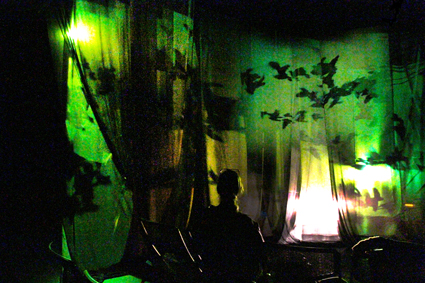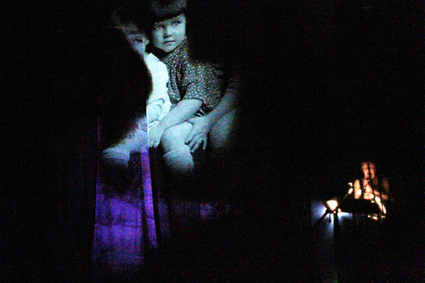time as music and image
jacques soddell: punctum, hourglass, bendigo

Hourglass
photo Sarah Kaur
Hourglass
HOURGLASS IS AN IMMERSIVE LIVE PERFORMANCE AND NEW MEDIA INSTALLATION THAT EXPLORES THE EXPERIENCE OF TIME. IT IS AN EVOLVING COLLABORATIVE WORK FEATURING A TEAM OF AUSTRALIAN AND MEXICAN ARTISTS INCLUDING NICOLE CANHAM (WHIRLY, CLARINET, TAROGATO), SARAH KAUR (VIDEO), IVAN PUIG (TECHNOLOGY ARTIST) AND CARLOS LOPEZ CHARLES (COMPOSER), WHO WERE BROUGHT TOGETHER BY A PUNCTUM IN-HABIT INTERNATIONAL GRANT TO DEVELOP THE FOUNDATIONS OF A NEW WORK.
Canham and Kaur had worked together previously, exploring the relationship between image projection and music performance, and Canham had also visited Mexico with the help of a Churchill Fellowship. The four artists initially spent an intensive period at CMMAS (Mexican Centre for Music and Sonic Arts) developing their concepts and working relationships, then a period of virtual collaboration and, finally, a week in Bendigo to workshop their ideas, resulting in a performance encapsulating some of their thoughts and experiments. We experienced a 25-minute sampler of a projected hour-long work involving the four artists and Rodrigo Sigal (composer), Drew Crawford (composer), Jose Luis Garcia Nava (new media artist) and Javier Alvarez (composer). It featured works specially written for Hourglass, but also earlier works adapted for the performance. The final version will probably consist entirely of works specially written for the project.
The aim was to create an immersive space that accommodates electroacoustic music, video, installation and a live performer, breaking away from the often formal presentation of new music. Layered black chiffon separated the audience from performer and installations, also acting as a multi-layered screen for video projection; the 3D rhythm generated by images slightly offset by the screens was enhanced by movement due to the airconditioning system. However, the audience was confined to a quarter of the space, restricting the immersive character of the visuals, while a 10-speaker system engulfed us.
Within this space we were presented with a series of musical vignettes centred on the passing of time or feelings generated by it, imagining the space as the inside of an hourglass (grains of sand fall from the ceiling at the end of the performance).
The program began with Into the Hourglass, an improvisation developed by Canham and Charles for whirly and electronics. The tonal range of a whirly is limited but it was intriguing to see how the sounds were created. The computer manipulation was subtle and lingered after the instrument stopped. Kaur’s multi-projection of watery ripples was our first introduction to the black chiffon screen in this short, atmospheric mood piece.

Hourglass
photo Sarah Kaur
Hourglass
Not Alone for clarinet and live processing by Carlos Lopez Charles was really a musical duet in three dimensions. Canham’s clarinet fragments were picked up and manipulated by Charles using live digital processing (Max/MSP). The echoes, mimicking techniques he used as a rock guitarist in the 80s/90s, were expertly moved around the immersive speaker system. As the piece progressed, the clarinet took on a more delicate tone, resulting in a subtle dialogue between clarinet and computer-generated echo. Kaur’s visuals featured random abstract shapes which may have felt more appropriate had their rhythm echoed the looping character of the music.
Next came a short performance by Ivan Puig’s glass bottle contraption (a miniature reference to his beautiful light and sound glass machine, “Mandalas for a Modern Life”), which was both too brief and difficult to see because of its size and positioning. The projected text—“Is it wise, the way the clock turns?”—reminded us of the premise for Hourglass. Puig’s complex machines have a wonderful character of their own and it was a pity his creative contribution was relatively minor here because of the short time he had in Australia. Hopefully the full version rectifies this.
Rodrigo Sigal’s “Vida Lunar” for clarinet and tape was the most substantial piece on the program. Adapted from a piece written for alto flute, all the components came together here: Canham’s extended clarinet techniques, Charles’ immersive diffusion of the complex electronic score and Kaur’s vintage monochrome family photos floating throughout the space.
Paula Matthusen’s “Before the Weather Changes” for sampled tarogato and electronics introduced us to the haunting sounds of the tarogato, a Hungarian folk woodwind recently adopted by Canham for development of a contemporary repertoire. This meditative piece was designed to include a live interactive video, a moving starscape by Jose Luis Garcia Nava, possibly created in “Processing,” but in this performance a video record from a previous performance was screened.
The program finished with Australian composer Drew Crawford’s “Time Flies When You’re Having Fun” for tarogato and tape, which turned out to be a three-minute sketch for a longer piece being developed for Hourglass. Featuring live and looped tarogato and some recorded percussion, it created a playful mood, but didn’t have time to develop. The best part was Kaur’s poetic video manipulation of images of a flock of birds.
Many in the audience were enthralled by Hourglass, but I felt a little hesitant. I sometimes feel sympathy for Francisco Lopez who blindfolds his audience, removing distractions from the listener. Hourglass went to the other extreme, not only immersing the audience in sound, but ensuring they kept their eyes open. Before the performance Canham said “we were less interested in utilising new technologies or looking into ground-breaking techniques as we were in exploring the poetic, the beautiful and narrative ways our art forms could interact.” This worked best in Rodrigo Sigal’s piece where all the elements came together and would have been even better had the audience been free to move around and feel the work—as planned for the future.
Punctum’s Hourglass, artists Nicole Canham, Sarah Kaur, Ivan Puig, Carlos Lopez Charles and guests, Old Fire Station, Bendigo, May 28-29
RealTime issue #104 Aug-Sept 2011 pg. 49






